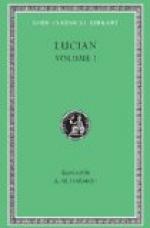The State arms are very peculiar and appropriate. The main figure is that of an Indian lying upon a bank, scattering flowers around him. In the distance the sun is setting amid beautiful hills. In the center there is a river with a steamboat upon it, and with a large cocoanut tree growing by the side. The State’s motto is one which has been adopted by many communities, but which is ever welcome for the purpose—“In God We Trust.”
In regard to its climate, Florida can offer a great deal of variety. Consumptives by the tens of thousand have sought a renewed lease of life in the warmest sections of the State, and many have come back greatly benefited. The winters are of the Indian summer order, being singularly dry, healthy and free from dust. The Gulf Stream adds from five to ten degrees to the temperature in cold weather, and in the southern section the temperature rarely gets below freezing point. The exceptionally cold spell of 1894-95 may be quoted as quite an exception to the general rule, and the heavy loss to growing fruits was as great a surprise as it was a loss.
Florida has the honor of being the first portion of North America to be discovered by white people. Ponce de Leon, whose very name is suggestive of romance and poetry, explored a section of the country in the year 1513, when he proclaimed the sovereignty of Spain over it. In 1527, a Spanish company of soldiers attempted to drive out the native inhabitants. The attempt failed, but another one some fourteen years later was more successful. Spain was not given a clear title to the peninsula without protest. French Huguenots built Fort Caroline on St. John’s River at about the middle of the century. Shortly after this enterprise, a Spanish fleet surprised and annihilated the pioneers, upon whose graves they placed the inscription, “Not as Frenchmen, but as Lutherans.” This brutal attempt to give a religious aspect to the murder was resented very soon after. A French expedition captured the fort, hung the garrison one after the other, announcing that they did so, and hanged the ruffians “Not as Spaniards, but as traitors, thieves and murderers.”
West Florida was settled at the close of the Seventeenth Century, and in 1763 the territory now included in the State was ceded to Great Britain in return for Cuba. Colonization followed, and a very large number of British Tories settled in the country. In 1814, the United States seized portions of the country, and four years later it became evident that European rule must cease in it. When in 1821 Spain ceded this territory to the United States, the number of white inhabitants was barely 600, although there were fully 4,000 Seminoles residing in it.
The Seminole War commenced in 1835, and continued for seven years. The war cost some $20,000,000, and over 1,500 American soldiers lost their lives during the campaign. Over 30,000 troops were engaged in the conflict, and the Indians by taking advantage of their knowledge of the country, held out against superior force for an extraordinary length of time. Gradually the savages were driven south, and at last the Seminoles were overpowered. Those who survived were for the most part sent west of the Mississippi River. A few are still found, however, on a reservation some fifteen miles from Fort Pierce on Indian River.




